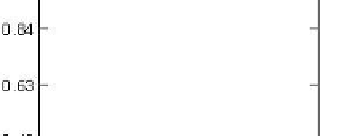Biology Reference
In-Depth Information
FOUNDERS
Fig. 7.12.
Effects of loci array characteristics on observed heterozygosity in founding
populations of different sizes when founders are drawn from a source population with either
one locus with 100 alleles of equal frequency = 0.01 (upper data points), or when the source
population has 50 loci, each with two alleles (one with frequency = 0.99, the other = 0.01;
lower data points). Both founding populations have a potential maximum total of 100 unique
alleles. The extent of the range of 25 founder group samplings (sample founder groups had
either 100, 200, 300, or 400 founders) is shown. Outliers are indicated by an asterisk. None
of the means among the higher points differed signifi cantly, nor did means among the lower
points (p >> 0.05 in t-test comparisons).
Fig. 7.11 generate these values of H for each level of founding individuals
drawn from source population one (top points) or two (bottom points), but
also there is less variation in the heterozygosity trial values than in the values
for the unique alleles retained, even when only 100 founders are selected.
This suggests that in some cases of founding populations of equal size, it
may be more important to consider variation in loss of unique alleles than
heterozygosity when evaluating biodiversity preservation. In Fig. 7.12,
none of the means in the upper group signifi cantly differ from any of the
others, nor do any of the means within the lower group (p always >> 0.05
in these comparisons).
Lawrence et al. (1995: 97) state, “There is general agreement that it is the
frequency of the least frequent allele that overwhelmingly determines the
size of a sample required for a given probability of conservation.” While Fig.
7.11 supports this statement, it also demonstrates that the probability not
only is strongly affected by the single least frequent allele, but also decreases
as more and more unique alleles of low frequency occur at a locus, especially
with lower numbers of founders. Although the source population for all
of the founding populations in Fig. 7.11 has 100 unique alleles available,
because of differences in loci allelic array composition, the case where allele
frequencies are more unevenly distributed (where there are 50 loci, each
with two possible alleles of frequencies 0.99 versus 0.01) gives a higher mean



Search WWH ::

Custom Search